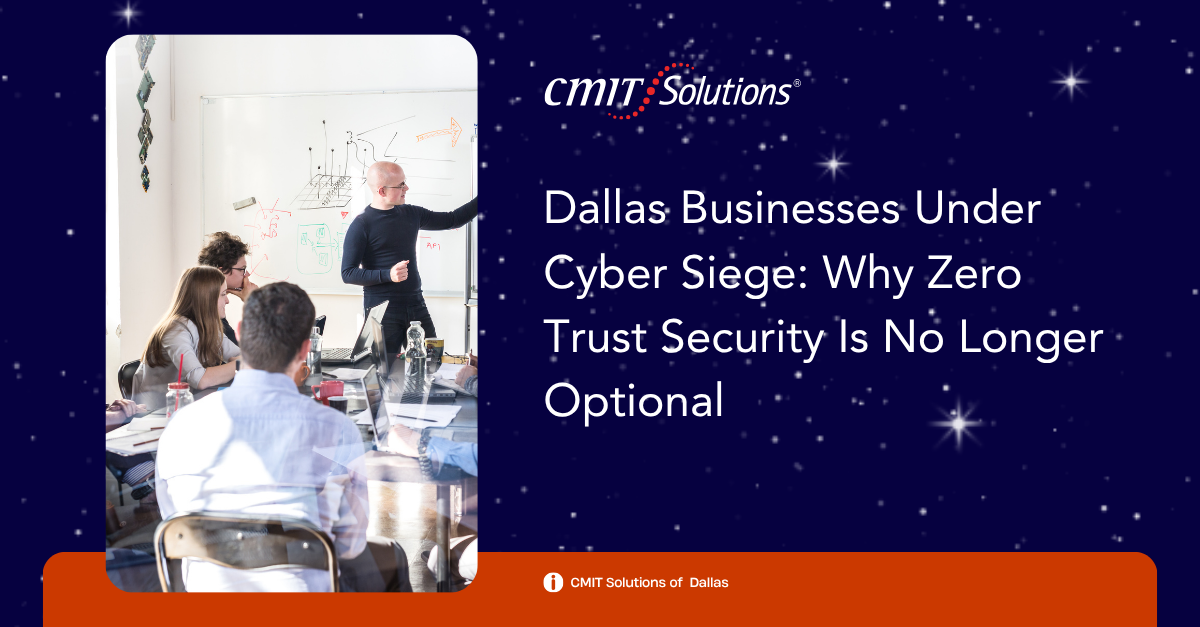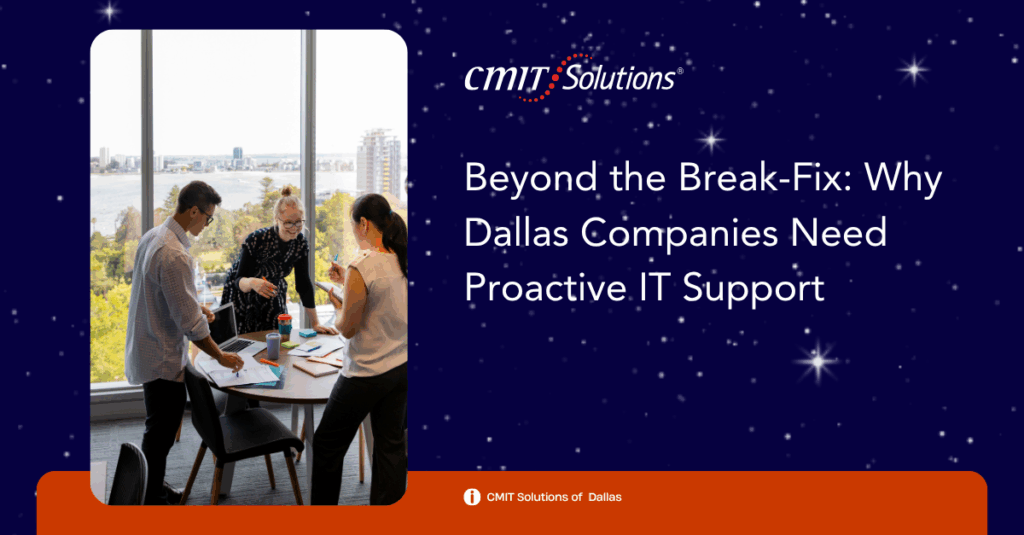Introduction: The Cyber Storm Brewing Over Dallas
In the fast-paced economic landscape of Dallas, businesses are thriving, scaling, and innovating at record speeds. But with this rapid growth comes a darker shadow: a surge in cyber threats targeting small and midsized companies. From ransomware attacks on supply chains to sophisticated phishing scams hitting law firms and healthcare providers, no sector is safe.
Dallas businesses are under cyber siege. The increasing frequency and complexity of attacks prove that traditional security models are no longer sufficient. Enter Zero Trust Security: a strategic, modern framework that assumes breach and requires continuous verification of every user and device.
Why Dallas Is a Prime Target
Dallas is a major economic engine in Texas, home to numerous industries including finance, healthcare, technology, and logistics. Its growing footprint in digital transformation makes it an attractive target for cybercriminals. Many businesses in the region are adopting cloud solutions, remote work policies, and Internet of Things (IoT) technologies—all of which expand the threat surface.
Additionally, small and midsized businesses in Dallas often lack the robust IT security infrastructure that larger corporations have, making them vulnerable entry points for cyber attackers. IT support for Dallas businesses has become more essential than ever.
The Shortcomings of Traditional Security Models
Conventional perimeter-based security assumes that anything inside the network can be trusted. But with hybrid work models and mobile devices, the network perimeter has effectively dissolved. This outdated approach fails to stop insider threats, credential theft, or lateral movement by hackers who gain initial access.
Firewalls, antivirus software, and basic authentication protocols no longer suffice. Cyber attackers are leveraging AI, automation, and social engineering to breach even well-guarded systems. A more adaptive, resilient, and context-aware model is needed. That’s why cybersecurity services in Dallas must now include advanced frameworks like Zero Trust.
Zero Trust: A Paradigm Shift in Cybersecurity
Zero Trust flips the conventional model on its head. The guiding principle is simple but powerful: “Never trust, always verify.”
Key components of Zero Trust Security include:
- Identity and Access Management (IAM): Ensures that users are who they claim to be, using multi-factor authentication and single sign-on tools.
- Least Privilege Access: Users are granted only the minimum level of access required to perform their duties.
- Micro-Segmentation: Breaks the network into smaller zones to limit lateral movement.
- Continuous Monitoring and Analytics: Real-time visibility and alerts to detect anomalous behavior.
- Endpoint Security: Constant validation of devices connecting to the network.
These elements are at the heart of robust IT compliance solutions in Dallas and ensure that businesses remain secure against evolving threats.
Zero Trust in Action: Real-World Scenarios
Consider a Dallas law firm that suffered a data breach because an employee clicked on a phishing link. With Zero Trust, even if the attacker had gained access to one part of the system, micro-segmentation would have prevented them from accessing client records or financial data.
Or take a local manufacturing company using IoT devices for automation. Zero Trust principles would ensure that each device is continuously authenticated, and any unusual activity—like accessing a server it normally doesn’t communicate with—would trigger an alert.
These examples demonstrate how managed IT services in Dallas can implement Zero Trust to reduce risk.
Benefits for Dallas-Based Businesses
Implementing Zero Trust offers several key advantages:
- Enhanced Security Posture: Real-time threat detection and response significantly reduce the chances of successful breaches.
- Regulatory Compliance: Helps meet standards like HIPAA, GDPR, and CCPA through strict access controls and audit trails.
- Improved Visibility: Continuous monitoring provides insight into user behavior, system performance, and potential vulnerabilities.
- Reduced Attack Surface: Least privilege access and segmentation make it harder for attackers to navigate the network.
These benefits directly support the digital resilience offered through cloud services in Dallas, especially as more companies adopt remote and hybrid work models.
Challenges and Misconceptions
While Zero Trust offers immense benefits, it’s not without its challenges. Misconceptions include:
- “Zero Trust is Only for Big Enterprises”: In reality, small and midsized businesses can and should adopt it incrementally.
- “It’s Too Expensive”: While there is an upfront investment, the cost of a data breach can be far greater.
- “It Slows Down Productivity”: Properly implemented, Zero Trust can streamline access through automation and policy-based controls.
Education and proper implementation through experienced IT consultants in Dallas help dispel these myths and ensure a smooth transition.
A Strategic Implementation Plan
For Dallas businesses ready to transition, here’s a step-by-step approach:
- Assess Current Security Posture: Identify gaps, assets, and risks.
- Define Protect Surfaces: Prioritize the most critical data and systems.
- Map Transaction Flows: Understand how users and data interact.
- Build Zero Trust Architecture: Implement IAM, segmentation, and monitoring tools.
- Educate and Train Staff: Foster a culture of cybersecurity awareness.
- Continuously Evaluate: Zero Trust is a journey, not a one-time project.
Each step can be simplified and accelerated by leveraging proactive IT support in Dallas.
The Role of Local IT Experts in Zero Trust Adoption
Partnering with a managed IT services provider can ease the transition. From designing secure network architectures to deploying advanced monitoring tools, these experts help businesses stay protected without overwhelming internal teams.
For businesses in Dallas looking for comprehensive cybersecurity solutions, consider working with a local IT provider deeply familiar with regional threats and compliance requirements. Small business IT solutions in Dallas are built to support companies with limited internal IT resources.
Why Immediate Action Is Critical
Every moment spent relying on outdated security frameworks is a window of opportunity for cybercriminals. With ransomware attacks now occurring every few seconds and data breaches costing millions, Zero Trust is no longer optional—it’s essential.
Cyberattacks don’t just cause financial losses. They erode customer trust, damage brand reputation, and invite legal scrutiny. For Dallas businesses striving to maintain resilience and competitive advantage, Zero Trust is the foundation of a secure digital future.
Conclusion: Fortify Your Digital Fortress Now
The cyber siege on Dallas businesses isn’t hypothetical—it’s happening right now. But with the right strategy, tools, and mindset, companies can turn the tide.
Zero Trust Security is not just a technology; it’s a philosophy that aligns with today’s threat landscape. By implementing its principles, Dallas businesses can safeguard their data, ensure compliance, and build a secure foundation for innovation.
To learn how your organization can deploy Zero Trust Security effectively, visit our Dallas cybersecurity page and take the first step toward proactive protection.







